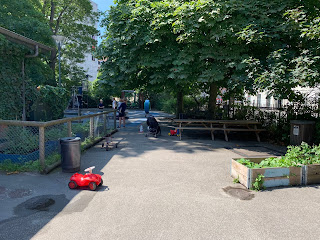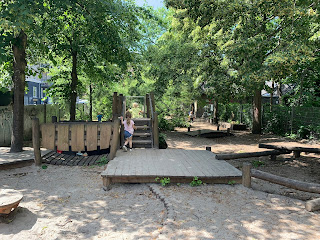Today's first activity was a meeting with Randa Ruben Jaber Sebelin. Sebelin is the coordinator of staff, for all staffed parks in Copenhagen. Staffed parks, which are unique to Copenhagen are playgrounds that contain 1-4 staff members at a time. originally started to keep children safe, there are now 26 (with a 27th being made) fully staffed parks that host events, activities, and continue to keep the children safe. They were created under the principles of play and movement, education, creating a meeting place, and creating safety. Along with this, the program has a lot to do with creating community. Not only do the staff make relationships with the children who are going to these parks but a lot of times they make relationships with the parents. Particularly in lower-income neighborhoods.
This meeting took place at Traffic Garden Park. This was a park designed to teach young children the traffic laws of the city and in particular how to bike around. They have small traffic lights, small stop signs, small bike tracks and even more. What is great about this park is that the children seem to really enjoy themselves while following the traffic laws.
The second part of the day was comprised of going to five random playgrounds around the city to observe them. My idea was to get a taste of small, large, staffed, and unstaffed playgrounds and see who uses them as well as how they're used.
The first park I stopped at was named Sankt Hans Gade. This quaint hidden park was designed into what seemed to be an alleyway at one point and was unstaffed. Bordered by trees and buildings it would be easy not to notice this park if riding or walking by quickly. While observing the park it's only use came from two different families with small children (my guess around 3 years old). It seemed to have a lot of practice for balance and running without much consequence if one were to fall.
Wesselsgade, the second park I attended was staffed. This park was packed with all age types and had multiple activities going on. in the basketball court area, there were small rails and jumps set up for young skateboarders, scooterers, and rollerbladers to practice and get better instead of jumping right into skate parks. This was being run by a young man, most likely in his mid-twenties. The second activity that was being staffed was a man teaching children and parents how to juggle. Now, this park was bigger and more full of older kids than the last, but it goes to show how lively they can get with planned activities.
This playground within Ørstedparken is normally staffed, but today no one was working. Much like the first one, this park was very secluded tall bushes and trees surround it so there are very few places you can see in from the outside. I am guessing this is for safety reasons, but I am beginning to think that this park might have also been designed with children with disabilities or with children on the spectrum in mind because it was a lot more chill and had nooks and crannies everywhere. I also found it quite interesting that they had raised bed planters near the staff house. I wonder if the staff ever teach the kids about them or the plants within them.
Skydebanehaven is a staffed park we have briefly visited, but by accident, I found myself here again and decided to sit down and observe. Complete with structures for most ages the demographics of this playground were all over the place. This playground offered a lot of structures that test the children's physical abilities and allow them to break any fears the might have. Whether that be climbing to the top of the giant rope pyramid, jumping on the zipline swing, or sliding down the parrot slide at a young age. This park was packed with kids and every structure was getting used.
The final park I went to I believe was not an actual city park. Much like the first one, it was small, surrounded by trees and full of younger children and their parents. This one also seemed to have a lot of practice for balance and motor skills while offering sand to cushion and falls.
While observing all these parks it amazed me how every single one was being used and how every structure within them was being used. I understand that it's summer, but when I would take my sister to the parks over the summer there always seemed to be a few structures that would never be touched. The second thing that was intriguing to me was how a lot of them seemed to be intentionally secluded. I assume that this is a safety precaution, but I wonder if some were designed for kids who are less social as well. And last but not least every park that was being staffed was packed, and whatever the staff member was doing was a hit with the children, even if it was passing out mini bikes or balls. I think this idea of staffed playgrounds is great and don't understand why it's so unique to Denmark. Not only does it provide more programs for the children, but it also provides more safety, something almost any park can benefit from.










Nice observations and an interesting range of parks!
ReplyDelete